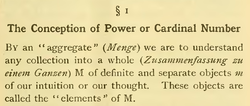Naive set theory
When people started to talk about sets, mostly in the 19th century, they did this using natural language. It uses many of the concepts already known from discrete mathematics; for example Venn diagrams to show which elements are contained in a set, or Boolean algebra. It is powerful enough for many areas of contemporary mathematics and engineering.[1] The term naive set theory is used for this kinds of set theory. It is usually contrasted with axiomatic set theory.
Naive set theory leads to a number of problems:
- Forming the set of all ordinal numbers is not possible because of the Burali-Forti paradox, discovered 1897
- Forming the set of all cardinal numbers is not possible, it shows Cantor's paradox (First Cantor's paradox)
- Forming the set of all things or sets is not possible; Second of Cantor's paradox (discovered 1899)
- The set of all sets that do not contain themselves is Russell's paradox, discovered 1902
There is a problem though: All the problems above can only be shown to be problems when axioms can be used to describe sets and their properties.
Richard Dedekind (1831-1916) discovered this and started a new set theory, in 1888. In his set theory, there are axioms about sets. His set theory is not good enough though:
- The set of all finite decimal numbers leads to Richard's paradox, discovered 1905
- The set of all finite natural numbers shows the Berry paradox, discovered 1908
- The set of all words describing a property they don't have is called the Grelling–Nelson paradox, also of 1908
Ernst Zermelo published a set theory in 1908. It uses axioms to define sets, and very much limits the ways in which sets can be made. Together with Abraham Fraenkel he is one of the creators of Zermelo–Fraenkel set theory, the set theory that was used for the much of the 20th century. Because of Gödel's incompleteness theorems this can only be proved for finite sets, though.
When teaching about sets in schools, naive set theory and the definition of Georg Cantor are sometimes used.
Naive Set Theory Media
References
- ↑ Mac Lane, Saunders (1971), "Categorical algebra and set-theoretic foundations", Axiomatic Set Theory (Proc. Sympos. Pure Math., Vol. XIII, Part I, Univ. California, Los Angeles, Calif., 1967), Amer. Math. Soc., Providence, R.I., pp. 231–240, MR 0282791. "The working mathematicians usually thought in terms of a naïve set theory (probably one more or less equivalent to ZF) ... a practical requirement [of any new foundational system] could be that this system could be used "naïvely" by mathematicians not sophisticated in foundational research" (p. 236).
